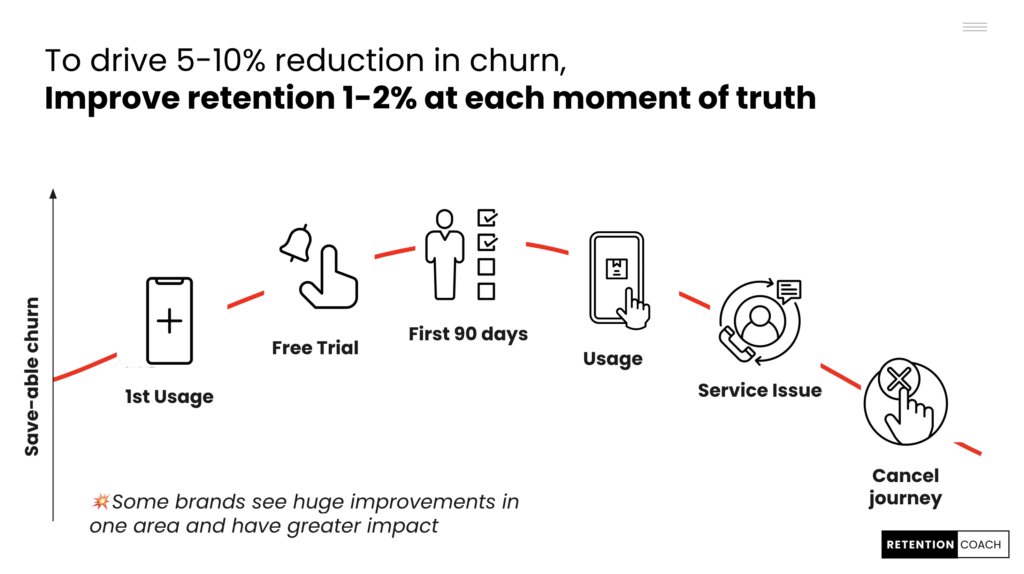

This article is from Tom Burrell's, Retention Blueprint Newsletter. Written specifically for Subscription businesses, 'The Retention Blueprint' is a free, retention-focused digest delivered straight to your inbox every Friday, providing you with the insights you need to drive retention-led growth.
What happens if you do not invest in retention
This is best explained with a hypothetical scenario…
At the start of the year, you have 100% of your customers. You expect to lose 10 percentage points, and you budget for 10pp customer growth overall to get you to 110% of the previous year’s customer number. The ‘plan’ bar in the graphic below:
Consider three scenarios where you miss your retention targets.
Scenario 1: You missed the retention targets by 10 percentage points. This means that in order to reach the 110% customer base target, the acquisition target needs to increase by 50%, from 20 percentage points to 30 percentage points.
Scenario 2: You missed the retention targets by 20 percentage points. This means that in order to reach the 110% customer base target, the acquisition target needs to double, from 20 percentage points to 40 percentage points.
Scenario 3: You missed the retention targets by 30 percentage points. This means that to achieve your overall 110% target, your acquisition target must increase by 250%, from 20pp to 50pp.
In any of these scenarios, you will need an increased acquisition budget, which will reduce profit, or you will need to accept lower growth or worse.
In simple terms, an effective retention strategy:
- Maximises profit protection
- Maximises the opportunity for profit growth without putting undue pressure on acquisition marketing
- Allows for cost optimisation/reduction because exceeding your retention target can allow for lower acquisition spend
Keep more customers than you budget for to spend less on acquisition
If you have an effective customer retention strategy and as a result retain more customers than you had planned, you can reduce your spend on customer acquisition. If this happens you will need to allocate less towards acquisition marketing to reach your targets and therefore your spend will be focused on attracting the easiest-to-reach customers, who tend to convert more cost-effectively. As a result, this can decrease your Customer Acquisition Cost (CAC), making your customer acquisition efforts even more efficient. Obvious right?
The example of First Republic Bank
Let’s take an example of a brand that did this so well at retention that it ended up spending virtually nothing on acquisition.
Between 2013 and 2019, 82% of First Republic Bank’s deposit growth was achieved without spending any acquisition marketing budget. First Republic’s retention strategy focuses on providing exceptional experiences from the beginning to ensure that the customer feels they made the right choice, delivering outstanding customer service, and recognising the moments that matter, such as giving customers notice before imposing a late fee. Their effective retention strategy led to high NPS (Net Promoter Score), and a very high number of customer referrals. As a result, First Republic customers deposited more money and referred others, resulting in outstanding deposit growth without any acquisition spend (Reichheld, F (2020) Winning on Purpose).
But let’s take this a step further….
Strategically focussed customer retention begins with an accurate CLV (Customer Lifetime Value) analysis. If you do this correctly, you will understand who your highest-value customers (critical for revenue protection), mid-value growth cohorts and low value customers are (see Retention Blueprint Newsletter 1 & 3 for more on this).
> To read more on CLV: A whistle stop tour of lifetime value
When CLV is used, it is often seen as a financial, customer, and retention metric and not always leveraged for acquisition efforts. Most acquisition teams use a single target for CAC (Customer Acquisition Cost), which results from an average customer value. Since there are always way more low-value customers than high-value customers in any given market, a blended approach to CAC (Customer Acquisition Cost) results in:
- Overspending on low-value customers and acquiring higher volumes than desirable.
- Underspending on high-value customers and acquiring less than desirable.
To drive more efficient acquisition spend and a more valuable return from your acquisition efforts:
- Invest in higher CAC to acquire higher-value customers based on the CLV of existing high-value customers and leverage look-a-like tools to find prospects that look similar to those high-value customers.
- Invest in lower CAC to acquire lower-value customers.
Let’s take a hypothetical example:
Red circles: In this example, leveraging a blended CAC would result in losing $1 on every low-value customer acquired.
Blue rectangle: If the brand spent $100k, leveraging a blended CAC approach, this brand would acquire 61 high-value customers, 242 mid-value customers and 1273 low-value customers, generating $153k CLV revenue.
Green Rectangle: If the brand instead used a CLV approach and spent $75k on acquiring 375 high-value customers, $20k on acquiring 200 mid-value customers and $5k on acquiring only 100 low-value customers (at an acceptable $50 CAC), the brand would generate $206k LTV revenue, 35% more than leveraging a blended approach. It would also acquire fewer customers, reducing retention cost per customer, and all customers acquired would be profitable.
An effective retention strategy focuses on the right customers at the right moments in the lifecycle
When you get retention right, you don’t miss your retention targets, and if you are doing well (like First Republic Bank), you can overachieve against them. If you do this, your acquisition spend becomes more efficient because you will invest less and your acquisition marketing efforts will focus on the lowest-hanging fruit and, as a result, become even more efficient. In addition, if you overlay one of the most important retention metrics; CLV, onto your acquisition marketing efforts, you can transform the value you generate and improve the profitability of your entire business.
Retention is key to growth since it drives ARR (Annual Recurring Revenue). It is also key to profitability because if you miss your retention targets, you must spend more. Hit your retention targets or overachieve, and business profitability soars. In fact evidence suggests that increasing customer retention rates by just 5% can increase profits by between 25%-95%…
So, how do you drive a 5-10% improvement in retention?
To drive 5-10% reduction in churn, improve retention 1-2% at each moment of truth.

As we explored in episode 1 of this newsletter, in any subscription business, there are key moments in the relationship: the first 90 days, or in life when usage drops, an important service issue, or the cancel journey—which are all often key moments of truth that require the most focus.
The key is to understand your business’s most important moments of truth and alter the experience to optimise retention.
Brands can understand the most important moments using analytics and data science to understand what happened immediately before a churn event or to identify which types of interactions, experiences, or behaviours have improved retention. They can also understand these moments through experiential NPS tracking or qualitative research.
Employing systems for onboarding (nurturing customers to undertake activities that benefit their long term usage), cancel journey management (which helps customers ponder the decision, without being obstructive), creating habit, customer love and embedding the product into customers lives are all vital here to improve retention at moments of truth (see previous newsletters for insight on all these areas).
Behavioural economics and proven channel execution techniques across CRM Marketing, product and customer service can also be important.
Final Thoughts
Small improvements in retention can lead to significant gains in profitability. As we’ve seen, a 5-10% reduction in churn can have a powerful impact on margins. The key to achieving this lies in focusing on retention at critical moments of truth, whether it’s during the onboarding phase, when customer engagement dips, or even in the cancellation process. By utilising data-driven insights and implementing proven retention systems, you can optimise these moments, reduce churn, and ultimately substantially improve profitability.
Here more from Tom to transform your retention impact in just 5 minutes per week, with ‘The Retention Blueprint’ Newsletter.












